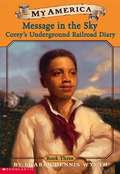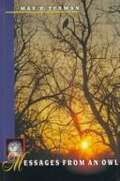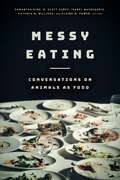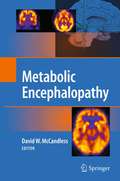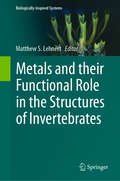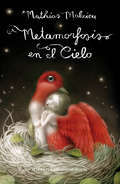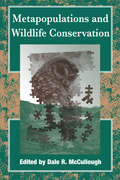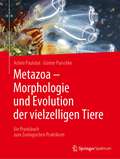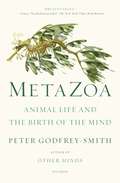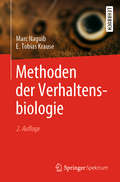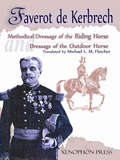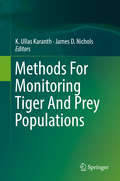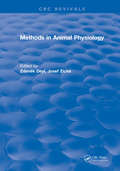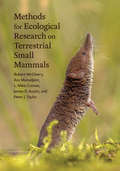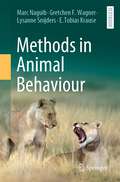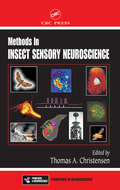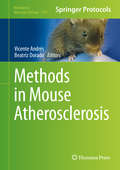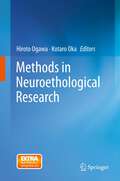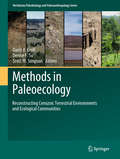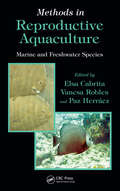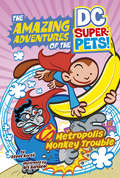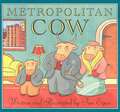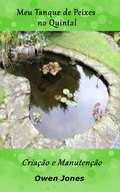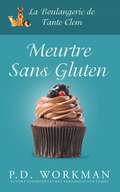- Table View
- List View
Message in the Sky: Corey's Underground Railroad Diary, Book 3 (My America)
by Sharon Dennis WyethIn "Message in the Sky", Corey begins attending school, and his family, along with his friend, Mingo, are living well in Canada, where they've built their own farm. But, the Birdsongs cannot let go of the memories of their friends left behind in America. Corey and Mingo hatch a plan to help Aunt Queen, Mingo's adopted mother, escape, but Corey's parents forbid it, and start saving money to buy her freedom, instead. However, when Corey accidentally ends up on the American side of the Ohio River, he finds himself a conductor on the Underground Railroad.
Messages from an Owl
by Max R. TermanFrom the Book Jacket: When zoologist Max Terman came to the rescue of a great horned owlet in the park of a small Kansas town, he embarked on an adventure that would test his scientific ingenuity and lead to unprecedented observations of an owl's hidden life in the wild. In Messages from an Owl, Terman not only relates his experiences nursing the starving owlet, "Stripey," back to health and teaching it survival skills in his barn, but he also describes the anxiety and elation of letting a companion loose into an uncertain world. Once Terman felt that Stripey knew how to dive after prey, he set the owl free. At this point his story could have ended, with no clue as to what the young bird's fate would be--had it not been for Terman's experimentation with radio tags. By strapping the tags to Stripey, the author actually managed to follow the owl into the wild and observe for himself the behavior of a hand-reared individual reunited with its natural environment. Through this unique use of telemetry, Terman tracked Stripey for over six years after the bird left the scientist's barn and took up residence in the surrounding countryside on the Kansas prairie. The radio beacon provided him with information on the owl's regular patterns of playing, hunting, exploring, and protecting. It enabled him to witness the moments when Stripey was bantered and mobbed by crows, when other owls launched fierce attacks, and when a prospective mate caught Stripey's eye. Stripey checked in occasionally with Terman back at the barn, following him around as he performed chores, usually waiting for a handout. Until now, scientists have generally believed that an owl nurtured by humans becomes ill-adapted for meeting the challenges of life in the wild. Terman's research proves otherwise. Stripey surpassed all expectations by becoming a totally independent wild creature. With Terman, however, Stripey remained tame, allowing the author to explore something one rarely sees in owls: a warm interest in humanity. Terman engagingly recreates this dimension of Stripey as he describes with humor and compassion the daily challenges of probing the life of a "phantom winged tiger."
Messy Eating: Conversations on Animals as Food
by Samantha King R. Scott Carey Isabel Macquarrie Elaine M. Power Victoria N. MilliousLiterature on the ethics and politics of food and that on human–animal relationships have infrequently converged. Representing an initial step toward bridging this divide, Messy Eating features interviews with thirteen prominent and emerging scholars about the connections between their academic work and their approach to consuming animals as food. The collection explores how authors working across a range of perspectives—postcolonial, Indigenous, black, queer, trans, feminist, disability, poststructuralist, posthumanist, and multispecies—weave their theoretical and political orientations with daily, intimate, and visceral practices of food consumption, preparation, and ingestion. Each chapter introduces a scholar for whom the tangled, contradictory character of human–animal relations raises difficult questions about what they eat. Representing a departure from canonical animal rights literature, most authors featured in the collection do not make their food politics or identities explicit in their published work. While some interviewees practice vegetarianism or veganism, and almost all decry the role of industrialized animal agriculture in the environmental crisis, the contributors tend to reject a priori ethical codes and politics grounded in purity, surety, or simplicity. Remarkably free of proscriptions, but attentive to the Eurocentric tendencies of posthumanist animal studies, Messy Eating reveals how dietary habits are unpredictable and dynamic, shaped but not determined by life histories, educational trajectories, disciplinary homes, activist experiences, and intimate relationships. These accessible and engaging conversations offer rare and often surprising insights into pressing social issues through a focus on the mundane—and messy— interactions that constitute the professional, the political, and the personal. Contributors: Neel Ahuja, Billy-Ray Belcourt, Matthew Calarco, Lauren Corman, Naisargi Dave, Maneesha Deckha, María Elena García, Sharon Holland, Kelly Struthers Montford, H. Peter Steeves, Kim TallBear, Sunaura Taylor, Harlan Weaver, Kari Weil, Cary Wolfe
Metabolic Encephalopathy
by David W. MccandlessMetabolic Encephalopathy is meant to combine and correlate animal and human studies. It is hoped that increased awareness of the importance of early diagnosis and treatment of these disorders may result in a lowering of the incidence of structural changes and morbidity. These disorders hold a special fascination for both basic scientists and clinical investigators because they are accessible, treatable and there exists good animal models for study. Therefore, this book will pull together basic and clinical neuroscience issue in the treatment of specific metabolic encephalopathies.
Metals and their Functional Role in the Structures of Invertebrates (Biologically-Inspired Systems #18)
by Matthew S. LehnertThis book showcases the diverse strategies used by invertebrate organisms to enhance their structures with metals. Written by the leading scientists in this multidisciplinary field, this book explores a range of metal-enhanced structures that span the world of invertebrates, their wonderous uses, and their applications to human-engineered products. The articles, accompanied by artistic imagery, reveal how metals augment the cuticle of insect mouthparts, the tongue of snails, the slime of slugs, and the claws of crabs. Intended for evolutionary biologists, material scientists, and anybody with an interest in invertebrate biology, this book covers what we currently understand about the adaptive value of metals in structures and lays a foundation for future studies.
Metamorfosis en el cielo
by Mathias MalzieuUna fábula que nos habla del poder de la vida y del amor. Todos tenemos sueños, y el del joven Tom «Hematoma» Cloudman es volar. Por eso es acróbata -algunos dicen que el peor acróbata del mundo- y especialista en escenas de riesgo, pues así se siente más cerca del cielo. Entre saltos y piruetas su cuerpo se desgasta, hasta que un día le detectan una grave enfermedad. Pero el destino de Tom no es el de cualquiera, y si le acompañamos veremos que poco después, en uno de sus paseos nocturnos por la clínica, conoce a una fascinante criatura, mitad mujer y mitad pájaro, de quien cae fulminantemente enamorado. ¡Pobre Tom! Lo que no sabe es que esa criatura tiene la llave de su destino. La mujer pájaro le propone un trato: «Yo puedo convertirte en pájaro y curarte, aunque tienes que asumir todas lasconsecuencias. Para activar tu metamorfosis, tienes que hacerme el amor.La metamorfosis del amor podría salvar tu vida. O no.» Si Tom es fiel a sus sentimientos, tendrá que dar un paso irreversible: transformarse y abandonar la vida humana por una nueva aventura... y es que, ¿en qué estamos dispuestos a convertirnos por amor? La crítica ha dicho...«Uno de los libros más cautivadores de la temporada.»El País
Metapopulations and Wildlife Conservation
by Dale Richard Mccullough Jonathan Ballou Glen Woolfenden Bradley Stith F. Lance Craighead Bill PrantyDevelopment of rural landscapes is converting once-vast expanses of open space into pockets of habitat where wildlife populations exist in isolation from other members of their species. The central concept of metapopulation dynamics -- that a constellation of partially isolated patches can yield overall stability to a system that is chaotic at the level of the individual patch -- offers an important new way of thinking about the conservation and management of populations dispersed among small habitat fragments. This approach is proving to be a rich resource for biologists hoping to arrest the current catastrophic loss of biodiversity.This volume provides a comprehensive overview of the subject, addressing the needs of an applied professional audience for comprehensible information to integrate into their practices. Leading conservation biologists, ecologists, wildlife managers, and other experts consider the emergence and development of metapopulation theory and explore its applicability and usefulness to real-world conservation programs. Conservation is essential reading for anyone working in the field of wildlife conservation and management.
Metazoa - Morphologie und Evolution der vielzelligen Tiere: Ein Praxisbuch zum Zoologischen Praktikum
by Günter Purschke Achim PaululatDie vielzelligen Tiere - Metazoa - haben im Laufe der Evolution alle erdenklichen Lebensräume, die unsere Erde bietet, erfolgreich besiedelt. Ihre Körper vollbringen dabei Höchstleistungen, um unter oft widrigen Bedingungen zu überleben, zu wachsen und zur Reproduktion zu kommen. Stetig Nachkommen zeugen, Gene weitergeben und durch Mutationen Anpassungen an sich ändernde und neue Lebensräume erreichen, ist das Erfolgsgeheimnis der Evolution. Aber wie ist der Körper eines Tieres aufgebaut, um solche Leistungen zu erbringen? Welche Organe besitzen Tiere, wie nehmen sie ihre Umwelt wahr, und in welchem evolutionären Zusammenhang stehen die auf den ersten Blick so unterschiedlichen Organismen? Dies sind nur einige exemplarisch ausgewählte Fragen, die sich jede Biologiestudentin und jeder Biologiestudent am Anfang des Studiums stellt. Dieses Buch stellt die wichtigsten Baupläne ausgewählter Tiere vor und ist als modernes Praxisbuch konzipiert. Es soll allen Studierenden, die im Rahmen Ihrer zoologischen Ausbildung in experimentellen Übungen Tiere präparieren, helfen, die grundlegenden Körperformen und -strukturen, die in den jeweiligen Tiergruppen auftreten, zu erkennen und zu verstehen. Was sind die wichtigsten Merkmale, die Nematoden, Anneliden, Insekten usw. auszeichnet und jeweils zum evolutiven Erfolg dieser Tiergruppen beigetragen haben? Wo gibt es Gemeinsamkeiten und wo Unterschiede? Wie viele unterschiedliche Lösungen hat die Evolution für ein bestimmtes biologisches Problem gefunden? Die Vermittlung der Morphologie und Anatomie der Tiere, ihrer so genannten Grundbaupläne und der evolutiven Zusammenhänge ist das Ziel des vorliegenden Werkes. Dafür setzen die Autoren konsequent auf fokussierte kompakte Texte und Fotografien, die nicht nur die wichtigsten äußeren Merkmale der Tiere zeigen, sondern auch die Präparation Schritt für Schritt nachvollziehbar machen. Die Autoren wünschen sich, dass alle Biologiestudentinnen und -studenten mit Hilfe dieses neuen Buches erfolgreich ihr Zoologisches Praktikum bestehen werden, und neue Einblicke in die Morphologie und Evolution der Tiere gewinnen.
Metazoa: Animal Life and the Birth of the Mind
by Peter Godfrey-Smith"Enthralling . . . breathtaking . . . Metazoa brings an extraordinary and astute look at our own mind’s essential link to the animal world." —The New York Times Book ReviewThe scuba-diving philosopher who wrote Other Minds explores the origins of animal consciousnessDip below the ocean’s surface and you are soon confronted by forms of life that could not seem more foreign to our own: sea sponges, soft corals, and serpulid worms, whose rooted bodies, intricate geometry, and flower-like appendages are more reminiscent of plant life or even architecture than anything recognizably animal. Yet these creatures are our cousins. As fellow members of the animal kingdom—the Metazoa—they can teach us much about the evolutionary origins of not only our bodies, but also our minds.In his acclaimed 2016 book, Other Minds, the philosopher and scuba diver Peter Godfrey-Smith explored the mind of the octopus—the closest thing to an intelligent alien on Earth. In Metazoa, Godfrey-Smith expands his inquiry to animals at large, investigating the evolution of subjective experience with the assistance of far-flung species. As he delves into what it feels like to perceive and interact with the world as other life-forms do, Godfrey-Smith shows that the appearance of the animal body well over half a billion years ago was a profound innovation that set life upon a new path. In accessible, riveting prose, he charts the ways that subsequent evolutionary developments—eyes that track, for example, and bodies that move through and manipulate the environment—shaped the subjective lives of animals. Following the evolutionary paths of a glass sponge, soft coral, banded shrimp, octopus, and fish, then moving onto land and the world of insects, birds, and primates like ourselves, Metazoa gathers their stories together in a way that bridges the gap between mind and matter, addressing one of the most vexing philosophical problems: that of consciousness.Combining vivid animal encounters with philosophical reflections and the latest news from biology, Metazoa reveals that even in our high-tech, AI-driven times, there is no understanding our minds without understanding nerves, muscles, and active bodies. The story that results is as rich and vibrant as life itself.
Methoden der Verhaltensbiologie (Springer-lehrbuch Ser.)
by Marc Naguib E. Tobias KrauseMarc Naguib erklärt die grundlegenden Methoden der qualitativen und quantitativen Erfassung von Verhalten. Dabei werden deskriptive und experimentelle Ansätze von Versuchsplänen berücksichtigt. Anhand von Beispielen aus der aktuellen Forschung wird die Breite der modernen verhaltensbiologischen Forschung anschaulich dargestellt.
Methodical Dressage of the Riding Horse and Dressage of the Outdoor Horse: From the Last Teaching of François Baucher as Recalled by One of His Students
by Michael L. M. Fletcher George De Lagarenne Faverot De KerbrechFaverot de Kerbrech's 'Methodical Dressage of the Riding Horse' is considered the 'Bible of Baucherism'. Together with it, in 'Dressage of the Outdoor Horse' General de Lagarenne gives us the teaching of Faverot de Kerbrech. Both excellently translated by Michael L. M. Fletcher. A horseman of great repute, Faverot remained the loyal successor to the work of François Baucher. The Master François Baucher brought numerous modifications to his first method of dressage. His best student, Faverot de Kerbrech gives us the definitive description and explanation of Baucher's second manner in his work: Methodical Dressage of the Saddle Horse from the Last Teaching of Baucher, recalled by one of his students (1891). Published twenty years after the death of Baucher, this work is the result of a quest to bring French equitation out of its academic approach; enriched by the experience of Baucher's most illustrious student. It is widely considered the best representation of Baucher's second method. In Dressage of the Outdoor Horse, General de Lagarenne gives us the last teaching of Faverot de Kerbrech. This work consists of a simplified progression of the second manner of Baucher with regard to the preparation of a horse for outdoor riding.
Methods For Monitoring Tiger And Prey Populations
by K. Ullas Karanth James D. NicholsThis book addresses issues of monitoring populations of tigers, ungulate prey species and habitat occupancy, with relevance to similar assessments of large mammal species and general biodiversity. It covers issues of rigorous sampling, modeling, estimation and adaptive management of animal populations using cutting-edge tools, such as camera-traps, genetic identification and Geographic Information Systems (GIS), applied under the modern statistical approach of Bayesian and likelihood-based inference. Of special focus here are animal survey data derived for use under spatial capture-recapture, occupancy, distance sampling, mixture-modeling and connectivity analysees. Because tigers are an icons of global conservation, in last five decades,enormous amounts of commitment and resources have been invested by tiger range countries and the conservation community for saving wild tigers. However, status of the big cat remains precarious. Rigorous monitoring of surviving wild tiger populations continues to be essential for both understanding and recovering wild tigers. However, many tiger monitoring programs lack the necessary rigor to generate the reliable results. While the deployment of technologies, analyses, computing power and human-resource investments in tiger monitoring have greatly progressed in the last couple of decades, a full comprehension of their correct deployment has not kept pace in practice. In this volume, Dr. Ullas Karanth and Dr. James Nichols, world leaders in tiger biology and quantitative ecology, respectively, address this key challenge. The have collaborated with an extraordinary array of 30 scientists with expertise in a range of necessary disciplines - biology and ecology of tigers, prey and habitats; advanced statistical theory and practice; computation and programming; practical field-sampling methods that employ technologies as varied as camera traps, genetic analyses and geographic information systems. The book is a 'tour de force' of cutting-edge methodologies for assessing not just tigers but also other predators and their prey. The 14 chapters here are lucidly presented in a coherent sequence to provide tiger-specific answers to fundamental questions in animal population assessment: why monitor, what to monitor and how to monitor. While highlighting robust methods, the authors also clearly point out those that are in use, but unreliable. The managerial dimension of tiger conservation described here, the task of matching monitoring objectives with skills and resources to integrate tiger conservation under an adaptive framework, also renders this volume useful to wildlife scientists as well as conservationists.
Methods In Animal Physiology
by Zdenek DeylThe aim of the present volume was to give an overview over different available methodological approaches. The specialists may, perhaps, object that in their particular field the level of information is superficial. However, let them look at other chapters in which different approaches are discussed and which, surely, will appear less superficial from the more general point of view. We hope, at least, that crucial references can be traced throughout the book that would enable the readers to go in more detail when desired. It can be traced throughout the book that would enable the readers to go in more detail when desired. It was really one of our ideas to draw the survey of possibilities available. If this can stimulate the readers to use ideas to draw the survey of possibilities available. If this can stimulate the readers to use other methods that those they are routinely using the goals will be met.
Methods for Ecological Research on Terrestrial Small Mammals
by Peter J. Taylor Robert McCleery Ara Monadjem L. Mike Conner James D. AustinAll the information researchers, students, and practitioners need to conducted innovative, state-of-the-art research on small mammals.Rodents and insectivores constitute the vast majority of mammals on our planet, yet we often overlook the importance of this group. As seed dispersers, prey species, and disease regulators, these animals are critical to the functioning of our ecological systems. While considerable material exists that describes these species, there has been no dedicated guide explaining how to effectively research them—until now. Methods for Ecological Research on Terrestrial Small Mammals is a one-stop resource compiling all the information readers need to conduct state-of-the-art research on small terrestrial mammals across the globe. The authors cover the full spectrum of issues, from capture, handling, identification, reproduction, demography, and taxonomy to behavior, diet, evolution, diseases, movements, morphometrics, and more. They also:• highlight the latest techniques while carefully explaining the tried-and-tested methods needed to conduct rigorous scientific inquiries; • provide step-by-step examples and case studies, demonstrating how the methods discussed can be used in actual research projects; • compare and contrast methodologies, analytical techniques, and software packages, helping researchers determine which pathways and tools will yield the best results for their studies. A comprehensive and invaluable resource, Methods for Ecological Research on Terrestrial Small Mammals is a must-have for any ecologist working on small mammals.
Methods in Animal Behaviour
by Marc Naguib E. Tobias Krause Gretchen F. Wagner Lysanne SnijdersMarc Naguib erklärt die grundlegenden Methoden der qualitativen und quantitativen Erfassung von Verhalten. Dabei werden deskriptive und experimentelle Ansätze von Versuchsplänen berücksichtigt. Anhand von Beispielen aus der aktuellen Forschung wird die Breite der modernen verhaltensbiologischen Forschung anschaulich dargestellt.
Methods in Insect Sensory Neuroscience
by Thomas A. ChristensenInsects are among the most diverse and adaptable organisms on Earth. They have long been our chief competitors for food and are responsible for spreading devastating afflictions such as malaria and encephalitis. The insects' ability to thrive is due in large part to their well-developed sensory systems, which present a host of novel physiological,
Methods in Mouse Atherosclerosis
by Vicente Andrés Beatriz DoradoThis volume reviews available mouse models of atherosclerosis, basic aspects of disease initiation and progression, and the visualization of atherosclerotic lesions with invasive and non-invasive techniques that are widely used both in basic research and in the clinic. The chapters catalogue a wide range of in vitro and in vivo experimental methods used for atherosclerosis research, including thorough protocols and valuable notes based on the authors' personal wet lab experience. Written in the highly successful Methods in Molecular Biology series format, chapters include introductions to their respective topics, lists of the necessary materials and reagents, step-by-step, readily reproducible laboratory protocols, and key tips on troubleshooting and avoiding known pitfalls. Authoritative and practical, Methods in Mouse Atherosclerosis will be a valuable working guide for researchers performing mouse-based atherosclerosis studies.
Methods in Neuroethological Research
by Hiroto Ogawa Kotaro OkaThe rapid progress of neuroscience in the last decade can be largely attributed to significant advances in neuroethology, a branch of science that seeks to understand the neural basis of natural animal behavior. Novel approaches including molecular biological techniques, optical recording methods, functional anatomy, and informatics have brought drastic changes in how the neural systems underlying high-level behaviors such as learning and memory are described. This book introduces recent research techniques in neuroethology, with diverse topics involving nematodes, insects, and vertebrates (birds, mice and primates), divided into sections by research method. Each section consists of two chapters written by different authors who have developed their own unique approaches. Reports of research in "model animals" including C. elegans, Drosophila, and mice, which were not typical specimens in conventional neuroethology, have been deliberately selected for this book because a molecular genetic approach to these animals is necessary for advances in neuroethology. Novel methodology including optical recording and functional labeling with reporter genes such as GFP has been actively used in recent neurobiological studies, and genetic manipulation techniques such as optogenetics also are powerful tools for understanding the molecular basis of neural systems for animal behavior. This book provides not only these new strategies but also thought-provoking statements of philosophy in neuroethology for students and young researchers in the biological sciences.
Methods in Paleoecology: Reconstructing Cenozoic Terrestrial Environments and Ecological Communities (Vertebrate Paleobiology and Paleoanthropology)
by Darin A. Croft Denise F. Su Scott W. SimpsonThis volume focuses on the reconstruction of past ecosystems and provides a comprehensive review of current techniques and their application in exemplar studies. The 18 chapters address a wide variety of topics that span vertebrate paleobiology and paleoecology (body mass, postcranial functional morphology, evolutionary dental morphology, microwear and mesowear, ecomorphology, mammal community structure analysis), contextual paleoenvironmental studies (paleosols and sedimentology, ichnofossils, pollen, phytoliths, plant macrofossils), and special techniques (bone microstructure, biomineral isotopes, inorganic isotopes, 3-D morphometrics, and ecometric modeling). A final chapter discusses how to integrate results of these studies with taphonomic data in order to more accurately characterize an ancient ecosystem. Current investigators, advanced undergraduates, and graduate students interested in the field of paleoecology will find this book immensely useful. The length and structure of the volume also makes it suitable for teaching a college-level course on reconstructing Cenozoic ecosystems.
Methods in Reproductive Aquaculture: Marine and Freshwater Species (CRC Marine Biology Series)
by Elsa Cabrita Vanesa Robles Paz HerráezThe large amount of information on fish reproduction available is not always readily accessible to all interested parties. Written to appeal to aquaculturalists, conservation managers, and scientific researchers, Methods in Reproductive Aquaculture provides an overview of available techniques and addresses ways to improve depleted stocks of endange
Metropolis Monkey Trouble (The Amazing Adventures of the DC Super-Pets)
by Steve KorteA chunk of Kryptonite has turned Superman into a wild animal! He’s on the streets and looking to make monkey trouble. Can Beppo the Super-Monkey stop him from making Metropolis his playground?
Metropolitan Cow
by Tim EganBennett Gibbons is a very fortunate calf. His parents are prominent members of their herd and noted socialites. They live in a beautiful apartment and give Bennett everything he could want. Indeed, young Bennett is the luckiest little calf in the neighborhood. Problem is, he's the only little calf in the neighborhood. Bennett is happy to become friends with Webster, a young pig who lives next door. But when his parents forbid the friendship Bennett runs away, and his parents soon learn the value of a good friend.
Meu Tanque de Peixes no Quintal: Criação e Manutenção (Como fazer... #6)
by Owen JonesEspero que você considere o conteúdo proveitoso, útil e valioso. As informações neste e-book, sobre vários aspectos bem simples e básicos da criação de peixes, estão organizadas em 17 capítulos com cerca de 500-600 palavras cada. Espero que seja de interesse para aqueles que desejam ganhar dinheiro online. Como um bônus, estou concedendo a você a permissão para usar o conteúdo em seu próprio site ou em seus próprios blogs e boletins informativos, embora seja melhor você reescrever com suas próprias palavras antes de publicar. Você também pode dividir o livro e revender os artigos. Na verdade, o único direito que você não tem é revender ou doar o livro como ele foi entregue a você. Se você tiver algum comentário, envie-o para a empresa de quem comprou este livro.
Meurtre sans Gluten (La Boulangerie de Tante Clem #1)
by P. D. WorkmanErin Price arrive à Bald Eagle Falls, une petite ville où les secrets n’existent pas et où les affaires de chacun sont de notoriété publique. Après avoir hérité du salon de thé de sa tante, elle décide d’y ouvrir une boulangerie sans gluten. Cependant, l’inauguration tourne au drame lorsque sa rivale, Angela Plaint, est retrouvée morte dans le sous-sol de la boulangerie. Erin se retrouve immédiatement suspectée du meurtre. Pour prouver son innocence, Erin se lance dans une enquête périlleuse, armée de ses pâtisseries et de son esprit déterminé. Avec l’aide de Vic, sa fidèle assistante, elle collabore avec l’inspecteur Terry Piper pour élucider ce mystère troublant. Mais à Bald Eagle Falls, les choses ne sont jamais simples : des rumeurs de chasse au trésor, de trafic de drogue, et la mystérieuse disparition d’un garçon viennent compliquer l’affaire. Erin devra naviguer entre indices et fausses pistes pour découvrir la vérité, tout en tentant d’échapper à un dangereux criminel qui pourrait bien faire d’elle sa prochaine victime.
Mew is for Murder (Theda Krakow Series #1)
by Clea SimonTheda Krakow is in a funk. Her sometime boyfriend is gone, her beloved cat has died, and the career leap she's made from copy editor to freelance writer has left her finances—and her spirit—flat. She desperately needs a headline. One day, strolling in her Cambridge neighborhood, Theda spies an adorable stray kitten who leads her to an old woman holed up in a decrepit house full of cats. Could this be the story to catapult Theda out of the dumps? Or deeper into something more sinister?
